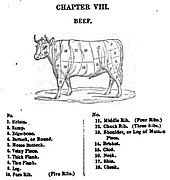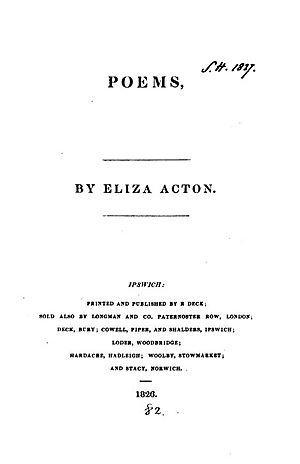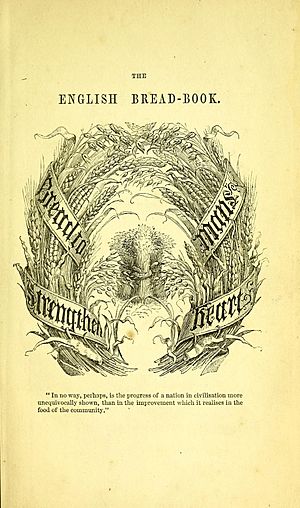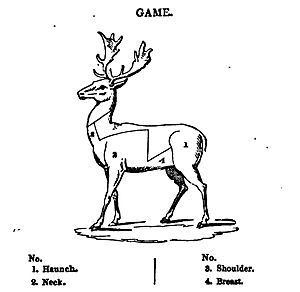Eliza Acton facts for kids
Quick facts for kids
Eliza Acton
|
|
|---|---|
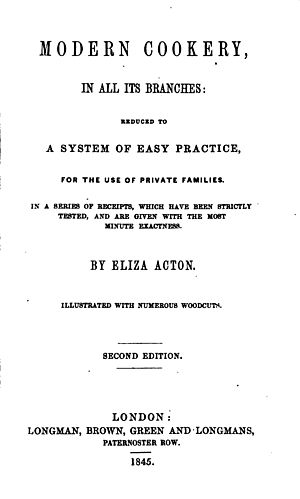
Frontispiece from Modern Cookery for Private Families, Acton's best known work
|
|
| Born | Elizabeth Acton 17 April 1799 Battle, Sussex, England |
| Died | 13 February 1859 (aged 59) Hampstead, London, England |
| Resting place | St John-at-Hampstead, London |
| Occupation | Poet, food writer |
| Notable work | Modern Cookery for Private Families |
Eliza Acton (born April 17, 1799 – died February 13, 1859) was an English food writer and poet. She created one of Britain's first cookbooks for families, called Modern Cookery for Private Families. This important book introduced a new way of writing recipes. It was the first to list ingredients and suggest cooking times for each dish.
Her book also included the first English recipes for Brussels sprouts and for spaghetti. She was also the first to call a popular dessert "Christmas pudding". Before her book, this dish was usually known as plum pudding.
Acton was born in 1799 in Sussex, England. She grew up in Suffolk, where she ran a girls' boarding school. Later, she spent some time in France. When she returned to England in 1826, she published a collection of her poems. Her famous cookbook, Modern Cookery, came out in 1845. It was written for middle class families and was very popular. The book was reprinted many times until 1918. In 1857, Acton published another book, The English Bread-Book for Domestic Use. This book was a more detailed study of bread-making. It included the history of bread in England, European baking methods, and many recipes.
Later, Modern Cookery was overshadowed by the very successful Mrs Beeton's Book of Household Management (1861) by Isabella Beeton. Mrs. Beeton's book included many recipes copied from Acton's work. Even though Modern Cookery was not fully reprinted for a long time, it has been greatly admired by English cooks in recent years. It has influenced many famous chefs, including Elizabeth David, Jane Grigson, Delia Smith, and Rick Stein.
Contents
Eliza Acton's Life Story
Early Years and Education
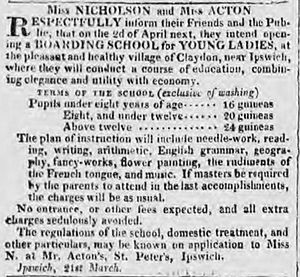
Eliza Acton was born on April 17, 1799, in Battle, Sussex. She was the oldest of six sisters and three brothers. Her parents were John Acton, a brewer, and Elizabeth Acton. Around 1800, her family moved to Ipswich, Suffolk.
In 1817, Eliza Acton opened a "boarding school for young ladies" in Claydon, near Ipswich. She later opened another school with her sisters in Great Bealings in 1819. This school moved to Woodbridge in 1822 and likely closed by 1825.
Early in her life, Acton spent some time in France. It is believed she traveled there around 1823 for her health. She returned to England, probably in 1826.
Her Work as a Poet
Eliza Acton began writing poetry by 1822. She wrote one poem, "On Approaching Paris," while she was in France in 1826. When she came back to England, she arranged for a collection of her poems to be published by Longman. Many people from Suffolk supported her by pre-ordering copies. 328 copies were printed in October 1826, and more were needed within a month.
She also wrote longer poems, such as "The Chronicles of Castel Framlingham" in 1838. Another poem, "The Voice of the North," was written in 1842 for Queen Victoria's first visit to Scotland. Other poems appeared in a local magazine called the Sudbury Pocket Book.
Around 1827, Eliza's father faced financial difficulties. Her family then moved to Bordyke House in Tonbridge, Kent. Her mother turned the large house into a boarding house for wealthy guests. These guests often visited Royal Tunbridge Wells for its spa facilities. Eliza Acton continued to live there for some time.
Becoming a Cookery Writer
At some point, Acton sent more poems to her publisher, Longman. The company reportedly suggested she write a cookery book instead. Acton spent ten years working on her cookbook. It was published in January 1845 with the title Modern Cookery in all its Branches. The book was written for the English middle class. In her introduction, she explained that knowing about household matters was important for educated women.
Modern Cookery mostly contains English recipes. However, Acton also included several recipes she called "French." There is a chapter on curries and potted meats. It also gives recipes for Eastern "chatneys" (chutney). The book has the first recipe for brussels sprouts. It also uses the word spaghetti for the first time in an English cookbook. Acton's book also has the first recipe for what she called "Christmas pudding."
Acton's recipes were unique because they listed the ingredients and the total cooking time. This was a new idea for cookbooks. She wrote that every recipe had been cooked and tested "under our own personal inspection." Food historians describe her cooking instructions as very careful and sensitive. They say her book was both a work of art and a useful guide.
Reviews for Modern Cookery were very positive. Critics called it "unquestionably the most valuable" cookbook published so far. They praised its clear instructions and the helpful lists of ingredients and cooking times.
A second edition of Modern Cookery came out in May 1845. It included corrections and updates. The book sold very well.
After Modern Cookery was published, Acton moved to Hampstead, London. She wrote about cookery for magazines like The Ladies' Companion and Household Words. She also started researching a book on food for sick people. She paused this research to write a new edition of Modern Cookery. This updated version was published in 1855 and was renamed Modern Cookery for Private Families. This is the name it is best known by today. This version added a chapter called "Foreign and Jewish Cookery."
Other cookbook writers often copied parts of Acton's successful book. In the introduction to her 1855 edition, Acton wrote about how her work was copied without giving her credit. She was in poor health during the 1850s. She mentioned that her hard work was affecting her health.
Acton had wanted to include more information about bread-making in her 1855 book. Despite her health, she decided to write a whole new book on the subject. This book, The English Bread-Book for Domestic Use, was published in May 1857. It was a serious, scientific study, not just a recipe book. It covered the history of bread-making in England and improvements made in Europe. It also looked at ingredients and different types of bread. Acton also included information about how flour millers and bakers sometimes added harmful things to bread. This book was less successful than Modern Cookery.
Eliza Acton suffered from poor health for much of her life. She passed away at home on February 13, 1859, at the age of 59. She was buried four days later at St John-at-Hampstead church in London.
Eliza Acton's Books
Her Poetry Works
Eliza Acton's poetry is seen as having humor and humanity. Her poems are described as romantic in style. They are considered well-written, though sometimes a bit old-fashioned. Many of her poems focused on nature and the evening. Some also explored themes of unrequited love.
Her Cookery Books
Modern Cookery is considered a very important cultural document because of Acton's excellent writing. Food writer Elizabeth David noted that Acton's book showed the food tastes of England before the Industrial Revolution. The dishes and ingredients she described would have been familiar to people from the 1700s.
Acton focused on "plain English dishes" in her recipes. However, she also included many recipes labeled as French dishes. Her book also had a chapter on foreign foods. These recipes came from places like India, Syria, Turkey, Italy, and Germany. Acton was open to learning from other food cultures. She believed people should learn from other nations without simply copying them.
Similarly, The English Bread Book focused on British bread. Acton wrote that bread was a basic need for most English people. She included a whole chapter on bread and bread-making in France, Germany, and Belgium. The book also has recipes for German pumpernickel, French baguettes, and Indian breads.
A strong theme in Modern Cookery is saving money when cooking. Acton advised using every healthy food item and making tasty meals from things others might throw away. For example, she gave a recipe for "Elegant Economist's Pudding" that used leftover Christmas pudding. She also offered a "Less Expensive Hare Soup" alongside a more fancy version.
Food writers praise Modern Cookery for its elegant writing and practical advice. The text is full of lively descriptions and opinions. Acton's recipes are seen as clear and helpful. Her writing also includes humor, especially when she describes a recipe that might go wrong. For example, she wrote that her "Publisher's Pudding" "can scarcely be made too rich." She also warned that putting marmalade on direct heat "will often convert what would otherwise be excellent preserve, into a strange sort of compound."
Eliza Acton's Lasting Influence
Modern Cookery was printed until 1918. After that, its popularity decreased due to other cookbooks. Acton's books were not widely available again until 1968. In that year, a selection of her recipes was published as The Best of Eliza Acton. Modern Cookery was not fully reprinted until 1994, but The English Bread Book was reprinted in 1990.
In 1857, when Isabella Beeton started writing a cookery column, many of her recipes were taken from Modern Cookery. In 1861, Isabella's husband published Mrs Beeton's Book of Household Management. This book also contained many of Acton's recipes. For example, about one-third of Beeton's soup dishes and a quarter of her fish recipes came from Acton. Isabella Beeton did follow Acton's new recipe layout, but she changed it slightly. Acton listed the cooking process first, then ingredients and times. Beeton listed times and ingredients first, then the cooking process.
Many modern cookery writers owe a lot to Acton's work. Elizabeth David said that The English Bread Book greatly influenced her own book, English Bread and Yeast Cookery. She also called Modern Cookery "the greatest cookery book in our language." The famous cook Delia Smith agrees, calling Acton "the best cookery writer in the English language." Other chefs like Jane Grigson and Rick Stein have also been influenced by Eliza Acton's work.
See also
 In Spanish: Eliza Acton para niños
In Spanish: Eliza Acton para niños



